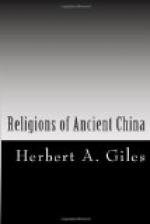Islamism.—Mahometans first settled in China in the year of the Mission, A.D. 628, under Wahb-Abi-Kabcha, a maternal uncle of Mahomet, who was sent with presents to the Emperor. The first mosque was built at Canton, where, after several restorations, it still exists. There is at present a very large Mahometan community in China, chiefly in the province of Yunnan. These people carry on their worship unmolested, on the sole condition that in each mosque there shall be exhibited a small tablet with an inscription, the purport of which is recognition of allegiance to the reigning Emperor.
Nestorians.—In A.D. 631 the Nestorian Church introduced Christianity into China, under the title of “The Luminous Doctrine;” and in 636 Nestorian missionaries were allowed to settle at the capital. In 781 the famous Nestorian Tablet, with a bilingual inscription in Chinese and Syriac, was set up at Si-ngan Fu, where it still remains, and where it was discovered in 1625 by Father Semedo, long after Nestorianism had altogether disappeared, leaving not a rack behind.
Manichaeans.—In A.D. 719 an ambassador from Tokharestan arrived at the capital. He was accompanied by one Ta-mou-she, who is said to have taught the religion of the Chaldean Mani, or Manes, who died about A.D. 274. In 807 the Manichaean sect made formal application to be allowed to have recognised places of meeting; shortly after which they too disappear from history.
Judaism.—The Jews, known to the Chinese as those who “take out the sinew,” from their peculiar method of preparing meat, are said by some to have reached China, and to have founded a colony in Honan, shortly after the Captivity, carrying the Pentateuch with them. Three inscriptions on stone tablets are still extant, dated 1489, 1512, and 1663, respectively. The first says the Jews came to China during the Sung dynasty; the second, during the Han dynasty; and the third, during the Chou dynasty. The first is probably the correct account. We know that the Jews built a synagogue at K’ai-feng Fu in A.D. 1164, where they were discovered by Ricci in the seventeenth century, and where, in 1850, there were still to be found traces of the old faith, now said to be completely effaced.
Christianity.—With the advent of the Jesuit Fathers in the sixteenth century, and of the Protestant missionaries, Marshman and Morrison, in 1799 and 1807 respectively, we pass gradually down to the present day, where we may well pause and look around to see what remains to the modern Chinese of their ancient faiths. It is scarcely too much to say that all idea of the early God of their forefathers has long since ceased to vivify their religious instincts, though the sacrifices to God and to Earth are still annually performed by the Emperor. Ancestor-worship, and the cult of Confucius, are probably very much what they were many hundreds of years ago; while Taoism, once a pure philosophy, is now a corrupt religion. As to alien faiths, the Buddhism of China would certainly not be recognised by the Founder of Buddhism in India; Mahometanism is fairly flourishing; Christianity is still bitterly opposed.




